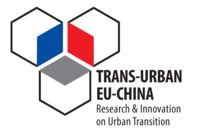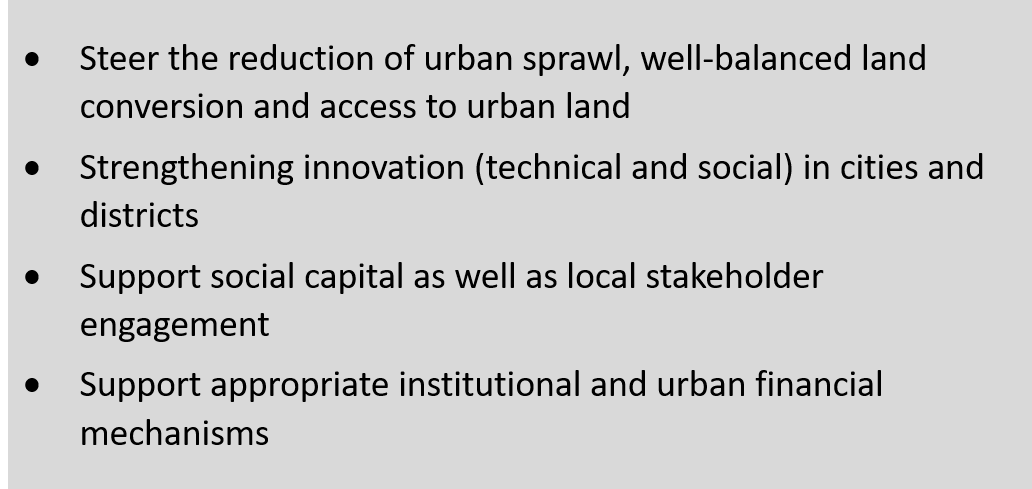
TRANS-URBAN-EU-CHINA
Transition towards urban sustainability through socially integrative cities in the EU and in China
Public Interim Purchase (PIP)
1. Purpose(s)
The public interim purchase is a strategy for the development of building land and enables the municipality to purchase land for different purposes. It can be a project-related interim purchase – the purchase of land is carried out for a specific project. Municipalities purchase the land, where it is needed for the project. Then, it is developed and reprivatized with special conditions or according to defined criteria (e.g. low purchase prices for mid income households or households with a lot of children).
Another type is the public interim purchase with regard to sustainable land banking (Dransfeld 2007). Land is bought in strategic locations for a cheap price (e.g. arable land) and held until needed. Thereby the instrument serves the expansion of building land supply (Kötter 2018). In general, the land is purchased early in the planning process, then the development of the area takes place and subsequently the land is resold.
In many European countries, interim purchases are also made for the redevelopment of land. There is no uniform procedure for urban redevelopment measure, but it can be a combination of individual measures: Interim purchase, reallocation, expropriation and the drawing up of a formal plan (Mattsson and Mansberger 2017; De Vries 2017).
For example, the German building code allows a special form of interim purchase as urban redevelopment measure. In defined tight urban situations, the municipality is allowed to expropriate the plot if the owners are not willing to sell their land (Deutscher Verband für Wohnungswesen, Städtebau und Raumordnung e.V. 2016). However, the preconditions for the application of expropriation are very high. There must be clear evidence of the necessity (according to the conditions laid down by law) and no other instruments should be available. In contrast, especially with regard to the creation of affordable housing in prospering cities, the urban redevelopment measure is becoming more and more attractive (Friesecke 2019). If the objectives cannot be achieved through income (through privatisation), subsidies can be applied (Mattsson and Mansberger 2017).
In various other European countries, corresponding procedures are implemented by expropriation or development of own land. Here, subsidies are also available in some cases (Nordahl and Eika 2017). Regional Development Agencies in the UK, as non-departmental public bodies, represent a special type in this regard. They were established for the purpose of the development of Englands Government Office regions until 2010 and were equipped with legal instruments (planning law, expropriation) and a high level of support. The follow-on institutions, the Local Enterprise Partnerships (LEPs), are voluntary partnerships between local authorities and businesses and are therefore less equipped than the predecessor.
Key Words: Land development, land purchase, increase value, social aspects, land supply policy
2. Relevance and Impact
Especially in urban expansion areas, public interim purchases are a common instrument for mobilizing building land. In consideration of the social challenges in many cities, this instrument enables the municipalities to provide building land in a targeted and demand-oriented manner. Thus, it is within the responsibility of the municipality to integrate aspects of socially integrative cities into urban development.
This instrument was selected by analyzing best practices in Europe. It was discussed in international working groups, where it was found that it is a classic procedure for the creation of building land, which is used in many European countries.
Public interim purchases can be the usual strategy to develop building land. In many cases, the instrument can be applied specifically with regard to the implementation of specific aspects. For example, the creation of building land for affordable housing is one of the main issues in European countries. Additionally, objectives of the political or administrative level, for example social mixing of urban districts or the creation of public service areas (e.g. schools, kindergarten) or green spaces in cities, can be realised better if the municipality owns the land itself.
Furthermore, the use of public interim purchases enables the implementation of special aspects at the place where measures of social integration are needed (Deutscher Verband für Wohnungswesen, Städtebau und Raumordnung e.V. 2016). Besides, the municipality can offer building land according to the demand (e.g. for mid and low income households) (Dransfeld 2007).
The main advantage of this instrument is that the municipality, or in the case of UK the public development company, has the planning rights and the ownership rights to achieve the urban development goals. By using the instrument, the municipality can directly steer the reduction of urban sprawl, well-balanced land conservation and access to urban land. The instrument can contribute to strengthen innovation (technical and social) in cities and districts. Interim purchases can support social capital and local stakeholder engagement. They can also support appropriate institutional and urban financial mechanisms (Box 1).
3. Strenghts
The procedure of public interim purchase provides the purchase by the municipality, the development of the area and finally the sale of the developed land. As a result, the public interim purchase is a tool, which refinances itself (Dransfeld 2007). Thereby, the purchase of the land should take place as early as possible in the planning process – if possible, at the land value of arable land. Because of this effect, the difference between purchase and sales price can be increased and the development become a cost-covering process.
One of the main advantages is the high level of public control. This results not only in a quantitative designation of building land but leads also to development with regard to implementation of special aspects (e.g. sale of land to certain groups of population for a low purchase price) (Dransfeld 2007, Deutscher Verband für Wohnungswesen, Städtebau und Raumordnung e.V. 2016).
Within the application of public interim purchase, two paths can be distinguished: At first, the municipality uses the land which is acquired by the public interim purchase and realizes this land. Furthermore, it is possible to realize special issues with regard to, for example, social integration at another place with the help of the generated profits by the sale of land from an interim purchase (Deutscher Verband für Wohnungswesen, Städtebau und Raumordnung e.V. 2016). In some cases, the municipality can involve private third parties and share the risk (e.g. special obligations to sell the developed land to third parties at lower prices). These advantages lead to financial relief for the municipal budget.
Summarized, the public interim purchase promotes the increase of population, which has a positive impact on municipal budgets because of higher tax revenues. A contractual agreement (building obligation) between the municipality and the purchaser of the land offers a possibility for the mobilisation of the area.
4. Weaknesses
Partly desolate budgetary situations of local authorities are the main problem of public interim purchases. In many European countries, the financial situation of local authorities is difficult due to high population losses. This means that there are not enough financial resources available for the purchase and development of land in case of public interim purchase. But there are instruments, which minimize the financial loss of the municipality (e.g. option contracts with the former owners) (Deutscher Verband für Wohnungswesen, Städtebau und Raumordnung e.V. 2016). Furthermore, the municipality bears the cost risk if the land cannot be sold (Dransfeld 2007, Deutscher Verband für Wohnungswesen, Städtebau und Raumordnung e.V. 2016).
Within the process of public interim purchases, the municipality should be aware of costs and revenues at all time. To this extent, it requires specially trained personnel, which many smaller municipalities cannot provide.
The main requirement of public interim purchases is the basic availability of plots in form of spatial availability, but also the willingness of the former owner to sell their plots. Here, the participation on the increase of land value or the demand of developed land can create incentives (Deutscher Verband für Wohnungswesen, Städtebau und Raumordnung e.V. 2016).
5. Good practice examples
Upton, Northampton (map)
At the beginning of 2001, the Regional Planning Guidance for the South East of England identified the South Midlands (i.e. large parts of Buckinghamshire, Bedfordshire and Northamptonshire) as potential population growth areas in England (Government Office for the East Midlands, 2005). In particular, Northampton borough was recognised as a place capable of accommodating household growth due to its character of a major population and employment centre. Upton, located at the south-west of Northampton provided an opportune location for the development of an urban expansion area, mainly since the land was publicly owned (The Scottish Centre for Regeneration, 2011).
Farmland was acquired by the Northampton Development Corporation and transferred to English Partnerships [1] (EP) in 1985. Outline planning permission for Upton was first granted in 1997 [2]. EP recovered its costs from land sales (public interim purchase) and in the event of any shortfall, through public subsidy. Additionally, EP set aside money to establish the Upton Management Company which charged every unit a management fee to cover the maintenance cost of the area (Scottish Government 2010).
Other key players in the development of Upton were The Prince's Foundation for the Built Environment [3] and EDAW (now AECOM consultant team) who in conjunction with EP developed the project through two Enquiry-by-Design events (consultation). EP's investment in advanced infrastructure drove development forward providing housebuilders with serviced parcels. A Working Group was established in 2001 to oversee implementation including representatives from all partners (TCPA, 2007). A design code including a comprehensive set of environmental standards was produced. Finally, different developers were selected by the Working Group for each of the eight sites within Upton. As a result, the UEA contains an "eclectic mix of housing styles" [4].
[1] A national regeneration agency sponsored by the Department for Communities and Local Government. It was also responsive to the growing political and policy interest in design and place-making.
[2] http://www.transportfornewhomes.org.uk/wp-content/uploads/2018/10/Upton-Northampton.pdf (retrieved May 7, 2020)
[3] It was a charity organization oriented to improve the quality of people’s lives by teaching and practicing timeless and ecological ways of planning, designing and building. The Prince’s Foundation was created by the merging of The Prince’s Foundation for Building Community, The Prince’s Regeneration Trust, The Great Steward of Scotland’s Dumfries House Trust and The Prince’s School of Traditional Arts in 2018. Source: https://princes-foundation.org/about (retrieved May 7, 2020)
[4] http://www.transportfornewhomes.org.uk/wp-content/uploads/2018/10/Upton-Northampton.pdf (retrieved May 7, 2020)
6. References
DE VRIES, W. T. 2017. Instruments of land mobilisation - concepts and examples. Coordinates XIII (2017-06).
DEUTSCHER VERBAND FÜR WOHNUNGSWESEN, STÄDTEBAU UND RAUMORDNUNG E.V. 2016. Mehr Bauland für bezahlbaren Wohnungsbau – Gute Beispiele kommunaler Boden- und Liegenschaftspolitik.
DRANSFELD, E. and PFEIFFER, P. 2007. Der Zwischenerwerb als Weg des kommunalen Baulandmanagements. In: fub (Flächenmanagement und Bodenordnung), 2/2007.
FRIESECKE, F. 2019. Die Renaissance der städtebaulichen Entwicklungsmaßnahme gem. §§ 165 ff. BauGB – Praxisbericht aus Sicht eines Entwicklungsträgers.
GOVERNMENT OFFICE FOR THE EAST MIDLANDS 2005. Regional Spatial Strategy for the East Midlands. In: MIDLANDS, G. O. O. T. E. (ed.). TSO.
MATTSSON, H. and MANSBERGER, R. 2017. Land Governance / Management Systems. A Conceptual Discussion. In: HEPPERLE, E., DIXON-GOUGH, R., MANSBERGER, R., PAULSSON, J., HERNIK, J. and KALBRO, T., eds, Land Ownership and Land Use Development. The Integration of Past, Present, and Future in Spatial Planning and Land management Policies. Zürich: vdf Hochschulverlag, 13-24.
NORDAHL, B. and EIKA, A. 2017. Urban Redevelopment and the (Mixed) Blassing of Multiple Ownership. In: HEPPERLE, E., DIXON-GOUGH, R., MANSBERGER, R., PAULSSON, J., HERNIK, J. and KALBRO, T. eds, Land Ownership and Land Use Development. The Integration of Past, Present, and Future in Spatial Planning and Land management Policies. Zürich: vdf Hochschulverlag, 89-106.
TCPA 2007. Best Practice in Urban Extensions and New Settlements. In: ASSOCIATION, T. A. C. P. (ed.). London: Town and Country Planning Association.
THE SCOTTISH CENTRE FOR REGENERATION, T. R. I. O. C. S. S. A. A. A. D. S. 2011. Delivering Better Places: Visual Case Study 6.
TRANS-URBAN-EU-CHINA. 2020. Land management instruments for socially integrative urban expansion and urban renewal in China and Europe. D 3.3 Report.
7. Author(s) of the article
Julia Süring, Paulina Schiappacacsse
